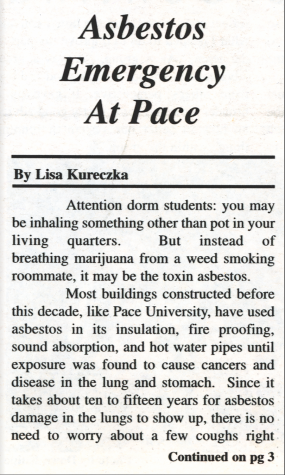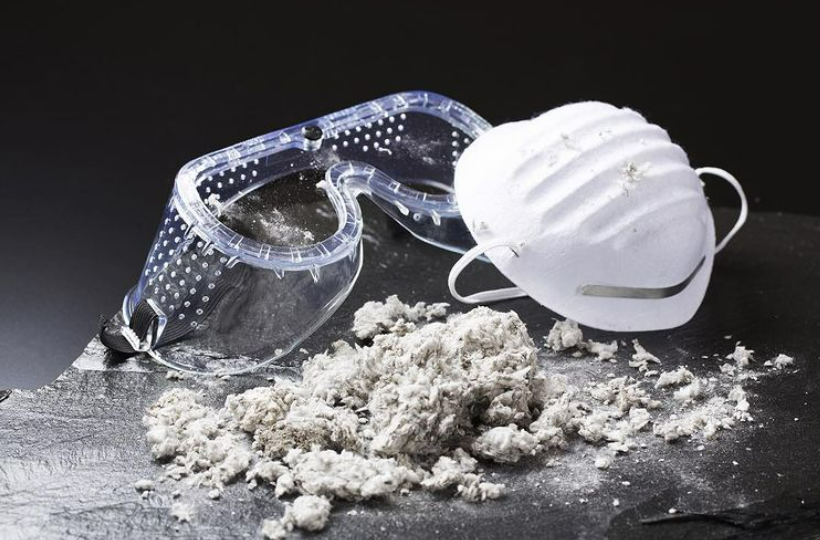Uncovering the falsehoods behind the rumored asbestos in Birnbaum Library and Maria’s Tower
September 22, 2022
As the class of 2026 begins to get settled on campus, rumors amongst first-year students have emerged that Maria’s Tower and the Birnbaum Library contain asbestos in the installation.
This is not the first time talks of asbestos have taken root on the University’s campus. In an archive newspaper of The Pace Press, released on July 25, 1998, “Asbestos Emergency at Pace” made front page news, noting that buildings constructed in decades past used asbestos for “insulation, fireproofing, sound absorption, and hot water pipes until exposure was found to cause cancers and disease in the lung and stomach.”


According to the United States Consumer Product Safety Commission, asbestos is a mineral fiber that, when damaged, can release asbestos fibers and become a health hazard. The commission says that even if materials contain asbestos, the public should remain healthy as long as no damage is done to release the fibers. At the University, the asbestos rumors have led to inconclusive thoughts and prompted a discussion about the chemical.
While students have rumored about the presence of asbestos in the Library and Maria’s Tower, there has been no evidence made public about the building having asbestos materials in the insulation of the building.
In the University master plan, which is currently underway, they have announced the creation of a new academic and residential building on Beekman Street is being constructed. Amenities included in this new building are a new cafeteria, classrooms, study spaces and student housing replacing Maria’s Tower on Spruce Street.
In order to safely remove asbestos from buildings, professionals must conduct walkthroughs before a building demolition to ensure public safety. The University has committed to safely disposing of asbestos if found in any buildings during any of the demolitions. According to financial statements from the University for June 30, 2021, money was allocated for demolishing buildings, as well as for proper disposal of asbestos if a building is demolished.
The University’s Facilities Department declined to comment about the rumors, while a University librarian said she had not heard of anything about them.
Updates as of Wednesday, Sept. 28:
The University’s Facilities Department has brought to light that “The asbestos in the majority of [Maria’s Tower] has been abated. Through proper testing, Asbestos is found in the fireproofing behind the walls in the public kitchen areas, but it does not pose health threats, since it is concealed and not disturbed.”
Facilities also conducted proper testing in the Library, which concluded that “Asbestos is found in the fireproofing behind the walls, and above the ceiling” and concludes the same precautionary measures pertinent to Maria’s Tower.
Facilities have taken precautionary measures to limit student and faculty exposure to the chemical, noting that “The asbestos found in the fireproofing is not a threat to the public unless the material disturbed, such as the case if there is demolition. The material is only disturbed during abatement. When asbestos abatement occurs, contractors must follow strict regulations to ensure that asbestos is not dispersed outside the work area. The abatement area is sealed and segregated from occupied/non-abatement areas using plastic sheeting. Only the abatement personnel with proper PPE and respirators are allowed to enter the abatement area once the project begins. This practice is strictly followed and monitored by an outside agency during abatement at the University. This is a standard process, and it is done properly ahead of each construction project. The University also provides air monitoring during an abatement project to ensure no exposure from the containment site.”
Additional information the Department wanted to disclose reflects what The Pace Press referenced in the 1998 archive, of which “Asbestos was commonly used in construction supplies, like pipe insulation or fire-proofing, in many pre-1987 buildings. Regulated building materials, like asbestos, pose no health risk when left alone and intact. During maintenance, renovation, or demolition in areas with asbestos-containing materials (ACM), building materials that may pose health risks are managed, abated and disposed of appropriately according to regulations to prevent exposure to building occupants and workers in accordance with NYC Dept. of Environmental Protection regulations. As long as the building materials are in good condition and undisturbed, they do not present a health risk to residents.”
At this time, there is no reason for concern; the asbestos present in Maria’s Tower and the Library does not pose a public health problem unless it is disturbed or physically damaged.












